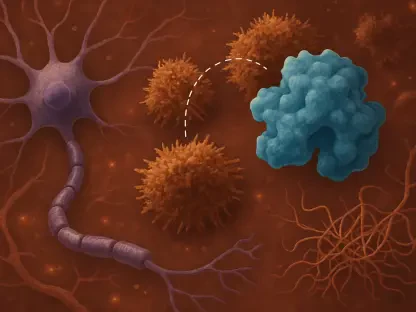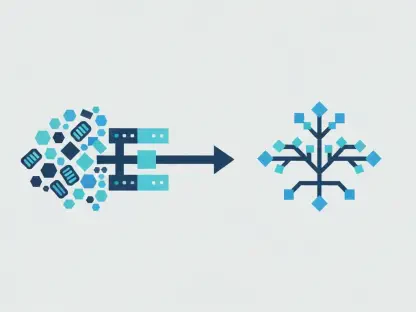Imagine a vast library of genetic information where countless pages, once dismissed as irrelevant scribbles, suddenly reveal hidden messages critical to understanding human health. This is the reality scientists are confronting as they delve into the genome’s so-called “junk DNA,” regions long ignored but now recognized as potential goldmines for medical breakthroughs. At the forefront of this exploration is a cutting-edge tool developed by researchers at the Salk Institute, designed to uncover microproteins—tiny yet powerful molecules encoded in these overlooked DNA stretches. This review dives into how this innovative technology is reshaping genetic science by illuminating the genome’s hidden potential.
Core Features of ShortStop Technology
Machine Learning Precision in smORF Identification
The cornerstone of this tool lies in its sophisticated machine learning framework, which sifts through vast genetic datasets to pinpoint small open reading frames (smORFs) that may encode functional microproteins. Unlike traditional methods that struggle to differentiate between biologically relevant sequences and irrelevant noise, this system employs a unique training approach. By using a negative control dataset of randomly generated smORFs as a comparison benchmark, it efficiently categorizes potential candidates, streamlining the discovery process.
This precision drastically reduces the pool of sequences requiring labor-intensive experimental validation. Researchers can now focus their efforts on the most promising leads, saving significant time and resources. The integration of computational intelligence in this manner marks a leap forward in tackling the complexity of genomic data.
Seamless Integration with Standard Data Formats
Another standout feature is the tool’s compatibility with widely accessible data types, such as RNA sequencing datasets, which are staples in many research labs. This adaptability ensures that scientists across various fields can readily incorporate the technology into their existing workflows without needing specialized equipment or data formats. Such accessibility broadens its appeal and practical utility in diverse scientific communities.
Beyond ease of use, this compatibility translates into tangible benefits by minimizing the learning curve and setup costs for research teams. Labs with limited budgets or technical expertise can still harness this powerful tool, democratizing access to cutting-edge genetic analysis and fostering broader collaboration in the field.
Performance and Real-World Impact
Transforming Microprotein Research Trends
The emergence of this technology aligns with a broader shift in genomic science, moving away from a narrow focus on large proteins toward a deeper appreciation of microproteins’ roles in biological processes. These small molecules, often fewer than 150 amino acids, were once overshadowed by their larger counterparts but are now seen as key regulators in health and disease. The tool’s ability to highlight these entities underscores its relevance in today’s research landscape.
By leveraging machine learning and big data, it addresses long-standing inefficiencies in identifying functional microproteins. This capability mirrors a growing trend in science to use computational tools to unravel complex biological puzzles, positioning the technology as a vital asset in modern genetic studies. Its contribution to this paradigm shift cannot be overstated, as it empowers researchers to explore previously uncharted genomic territories.
Practical Applications in Disease Research
In practical terms, the tool has already demonstrated its value through specific case studies, such as the analysis of a lung cancer dataset. Here, it identified 210 new microprotein candidates, with one showing notably higher expression in tumor tissue compared to healthy samples. This discovery points to potential applications as a biomarker or therapeutic target, illustrating the tool’s capacity to yield actionable insights.
Its versatility extends beyond oncology, with potential implications for other complex conditions like Alzheimer’s disease and obesity. By applying the technology to diverse datasets, researchers can uncover novel microproteins linked to various health challenges, paving the way for innovative diagnostic and treatment strategies. This adaptability highlights its broad relevance across medical research domains.
Challenges in Implementation
Validation Hurdles in Biological Relevance
Despite its strengths, a significant challenge remains in confirming the biological significance of identified smORFs. The tool excels at prioritizing candidates, but it cannot definitively establish their functionality, necessitating further experimental validation. This step remains a bottleneck, as lab-based testing is often resource-intensive and time-consuming.
Addressing this gap requires ongoing collaboration between computational and experimental scientists to refine the validation process. Until these hurdles are overcome, the technology’s full potential may be constrained by the limitations of downstream confirmation methods, underscoring the need for integrated research approaches.
Adoption Barriers in Research Workflows
Widespread adoption also faces obstacles related to integrating the tool into existing research frameworks. Many labs may lack the technical expertise or infrastructure to fully utilize its capabilities, creating a barrier to entry. Additionally, aligning its outputs with established protocols can pose logistical challenges for some teams.
Efforts to mitigate these issues are underway, with developers focusing on user-friendly interfaces and comprehensive training resources. Overcoming these adoption barriers will be crucial to ensuring that the technology reaches its intended audience and achieves maximum impact in genetic research.
Looking Ahead: Future Prospects
Enhancements on the Horizon
Looking toward the future, there is considerable scope for enhancing the tool’s machine learning algorithms to improve accuracy and predictive power. Potential updates could involve integrating larger and more diverse datasets to refine its ability to detect functional smORFs. Such advancements would further solidify its position as a leader in microprotein discovery.
Additionally, expanding compatibility with emerging data types and analytical platforms could broaden its applicability. As genetic research evolves, ensuring that the technology remains at the cutting edge will be essential for maintaining its relevance and utility over the coming years, from 2025 onward.
Broader Implications for Genetic Science
The long-term impact of microprotein research, bolstered by tools like this one, holds promise for revolutionizing diagnostics and treatments for complex diseases. By uncovering hidden genomic elements, scientists can develop novel therapeutic targets and personalized medicine approaches. This potential to transform healthcare underscores the importance of continued investment in such technologies.
Moreover, as more hidden aspects of the genome come to light, the foundational understanding of human biology may undergo a profound shift. This tool stands poised to play a central role in this transformation, driving discoveries that could redefine medical science in the decades ahead.
Final Thoughts
Reflecting on the evaluation, the journey of this genetic discovery tool proved to be a game-changer in the realm of microprotein research. Its innovative machine learning approach and compatibility with common data types delivered impressive results, from identifying lung cancer-related candidates to showcasing versatility across disease areas. Despite challenges in validation and adoption, its performance left a lasting impression on the potential to unlock the genome’s secrets.
Moving forward, the next steps involve prioritizing enhancements in algorithm precision and user accessibility to address existing limitations. Collaboration between computational and experimental fields emerged as a critical solution to streamline validation processes. As these efforts unfold, the tool’s role in shaping future genetic breakthroughs remains a compelling consideration, offering a beacon of hope for advancing human health through deeper genomic insights.









